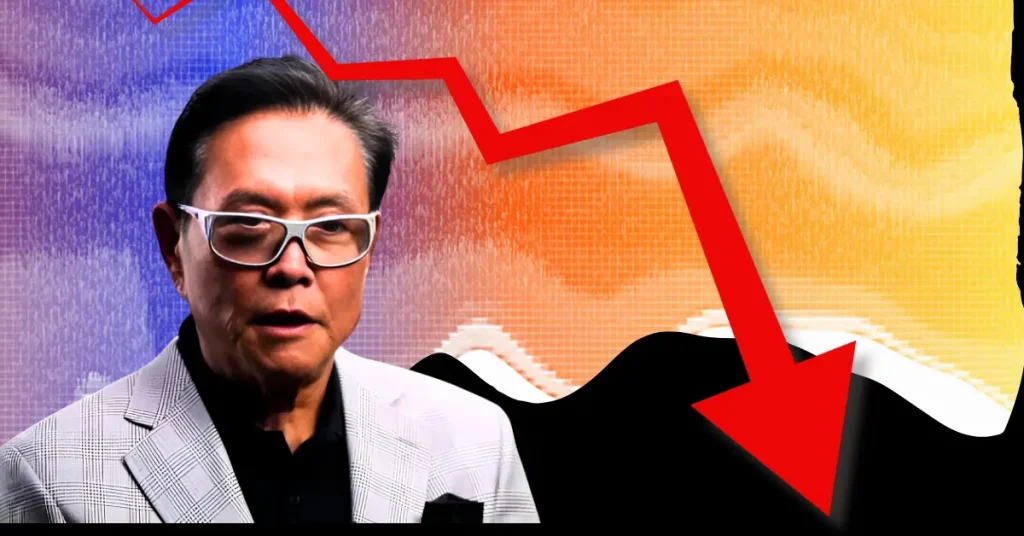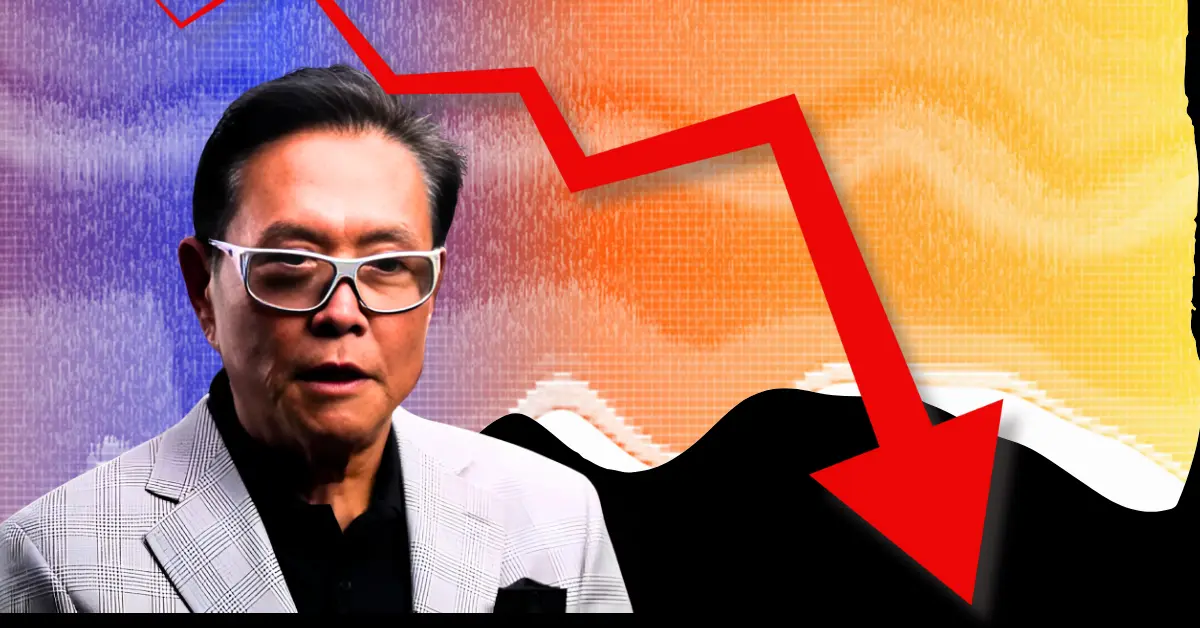
The Validity of Kiyosaki’s Economic Predictions: A Comprehensive Analysis
Introduction: The Man Behind the Message
Robert Kiyosaki, a name synonymous with financial education, has built a career on challenging conventional wisdom about money. His book *Rich Dad Poor Dad* has sold millions of copies, making him a household name in personal finance. However, his recent warnings about an impending economic catastrophe—one potentially worse than the 1929 Great Depression—have sparked intense debate. Kiyosaki’s predictions are not just about market fluctuations; they are a call to action, urging investors to abandon traditional financial strategies in favor of tangible assets like Bitcoin, gold, and silver. But how credible are these claims, and what should investors do in response?
The Economic Underpinnings of Kiyosaki’s Warnings
The Debt Crisis: A Ticking Time Bomb
Kiyosaki’s primary concern is the unsustainable level of U.S. national debt. As of 2023, the U.S. debt stands at over $34 trillion, a figure that continues to grow at an alarming rate. Kiyosaki argues that this debt is not only unsustainable but also a direct threat to the stability of the U.S. economy. The government’s reliance on printing money to service this debt, he contends, leads to inflation and a devaluation of the dollar. This, in turn, erodes purchasing power and creates economic instability.
The historical context is crucial here. The 1929 crash was precipitated by a combination of excessive debt, speculative bubbles, and a lack of regulatory oversight. Kiyosaki draws parallels between that era and today, suggesting that the current economic environment shares many of the same vulnerabilities. However, the scale of today’s debt is unprecedented, making the potential fallout even more severe.
The Everything Bubble: A House of Cards
Kiyosaki’s concept of the “Everything Bubble” is central to his argument. He posits that multiple asset classes—stocks, real estate, cryptocurrencies, and commodities—are simultaneously overvalued. This overvaluation, he argues, is fueled by low interest rates and excessive liquidity, creating a precarious situation where a single trigger could cause the entire bubble to burst.
The idea of an “Everything Bubble” is not entirely new. Economists have long warned about the dangers of asset bubbles, particularly in the wake of the 2008 financial crisis. However, Kiyosaki’s assertion that all major asset classes are overvalued is a bold claim. It suggests that the current economic environment is uniquely vulnerable, with no safe haven within traditional investment vehicles.
The Flaws of Traditional Investments
Kiyosaki is particularly critical of traditional investment vehicles like 401(k)s, especially those heavily invested in stocks and ETFs. He views these as being particularly vulnerable in a market crash, arguing that their value is directly tied to the performance of the stock market, which he believes is on the verge of collapse. Furthermore, he cautions against ETFs, suggesting they lack the security of owning tangible assets directly.
His critique of 401(k)s is not without merit. The 2008 financial crisis demonstrated the vulnerabilities of these retirement accounts, with many investors losing significant portions of their savings. However, the subsequent recovery also showed the resilience of the stock market. Kiyosaki’s argument ignores the long-term growth potential of equities, which have historically outperformed other asset classes over extended periods.
The Case for Alternative Assets: Bitcoin, Gold, and Silver
Limited Supply: A Hedge Against Inflation
Kiyosaki positions Bitcoin, gold, and silver as alternative assets that can weather the coming storm. His rationale is based on several factors, the first being the limited supply of these assets. Both gold and Bitcoin have a finite supply, making them resistant to inflation caused by the printing of more fiat currency. This scarcity, he argues, makes them a store of value in times of economic uncertainty.
The historical performance of gold supports this argument. During periods of economic turmoil, gold has often served as a safe haven, appreciating in value as other assets decline. Bitcoin, while a newer asset, has also demonstrated similar characteristics, particularly during times of market volatility.
Tangible Assets: A Sense of Security
Gold and silver are physical assets with intrinsic value, unlike stocks or bonds, which are based on the performance of companies or governments. This tangible nature provides a sense of security in a volatile market. Kiyosaki argues that owning physical assets can protect investors from the uncertainties of the financial system.
The tangible nature of gold and silver is a significant advantage, particularly in times of economic instability. These assets are not subject to the same market fluctuations as stocks or bonds, making them a more stable investment option. However, they also come with their own set of challenges, such as storage and insurance costs.
Decentralization: A Hedge Against Government Overreach
Bitcoin’s decentralized nature, free from government control, appeals to those who distrust central banks and fiat currencies. Kiyosaki sees Bitcoin as a hedge against government overreach and monetary manipulation. He argues that Bitcoin’s decentralized nature makes it immune to the same risks that plague traditional financial systems.
The decentralized nature of Bitcoin is one of its most compelling features. It operates independently of governments and central banks, making it resistant to manipulation. However, this decentralization also comes with risks, such as regulatory uncertainty and market volatility.
A Critical Examination: The Pros and Cons of Kiyosaki’s Predictions
The Perpetual Doomsayer: A Pattern of Predictions
Kiyosaki has a history of making dire predictions about the economy, and while some of his forecasts have been accurate, many have not materialized. It’s important to recognize this pattern and avoid blindly accepting his pronouncements. His warnings should be viewed in the context of his broader message, which emphasizes financial education and preparedness.
Oversimplification: The Complexity of Economic Systems
Economic systems are incredibly complex, and reducing the potential for a crash to a few key factors can be misleading. Multiple variables influence market behavior, and unforeseen events can dramatically alter the course of the economy. Kiyosaki’s oversimplification of the economic landscape may lead investors to make decisions based on incomplete information.
Potential Bias: The Role of Self-Interest
Kiyosaki has a vested interest in promoting alternative assets like Bitcoin, gold, and silver. His recommendations should be viewed in light of this potential bias, and investors should conduct their own independent research before making any decisions. It’s essential to consider the broader economic context and not rely solely on the advice of any single individual.
The Case for Diversification: A Balanced Approach
While Kiyosaki advocates for a significant shift towards alternative assets, most financial advisors recommend a diversified portfolio that includes a mix of stocks, bonds, real estate, and other asset classes. Diversification helps to mitigate risk and provides a more balanced approach to investing. A diversified portfolio can protect investors from the volatility of any single asset class, making it a more sustainable long-term strategy.
The Volatility of Bitcoin: A Double-Edged Sword
While Bitcoin has the potential for significant returns, it is also a highly volatile asset. Its price can fluctuate dramatically in short periods, making it a risky investment for those seeking stability. Investors should be aware of the risks associated with Bitcoin and only invest what they can afford to lose.
Navigating the Uncertainty: A Balanced Approach to Investing
Assessing Risk Tolerance: Know Your Limits
Understanding your comfort level with risk is crucial when making investment decisions. If you are risk-averse, you may want to consider a more conservative investment strategy. This could include a higher allocation to bonds, cash, and other low-risk assets. Conversely, if you are comfortable with higher levels of risk, you may be able to allocate a larger portion of your portfolio to stocks, real estate, and alternative assets.
Diversifying Your Portfolio: The Key to Mitigating Risk
Diversification is one of the most effective ways to mitigate risk. By spreading your investments across different asset classes, you can reduce the impact of any single market downturn. A diversified portfolio should include a mix of stocks, bonds, real estate, and alternative assets like gold, silver, and Bitcoin.
Exploring Alternative Assets: A Cautious Approach
Alternative assets like gold, silver, and Bitcoin can provide a hedge against economic uncertainty. However, they should be approached with caution. Investors should conduct thorough research and only invest what they can afford to lose. It’s also important to consider the broader economic context and not rely solely on the advice of any single individual.
Paying Down Debt: A Smart Financial Move
Reducing your debt burden can free up cash flow and provide greater financial flexibility during an economic downturn. Paying down high-interest debt, such as credit cards and personal loans, can also improve your credit score and make you more attractive to lenders.
Building an Emergency Fund: A Financial Safety Net
Having a readily accessible emergency fund can provide a buffer against unexpected expenses and job loss. Financial experts recommend having at least three to six months’ worth of living expenses saved in an emergency fund. This can provide peace of mind and financial security during times of economic uncertainty.
Staying Informed: The Power of Knowledge
Keeping abreast of economic developments and consulting with a qualified financial advisor can help you make informed investment decisions. The financial landscape is constantly evolving, and staying informed can help you adapt to changing market conditions. It’s also important to seek professional advice before making any significant financial decisions.
Conclusion: Preparing, Not Panicking
Robert Kiyosaki’s warnings of a looming market crash worse than 1929 serve as a stark reminder of the potential risks in the current economic environment. While his predictions may be overly pessimistic, they should not be dismissed entirely. The key takeaway is not to panic, but to prepare. By understanding the potential risks, diversifying your portfolio, and taking steps to protect your financial well-being, you can navigate the uncertainty with greater confidence and resilience. Ultimately, responsible investing is about making informed decisions based on your individual circumstances and risk tolerance, rather than blindly following the advice of any single individual, regardless of their perceived expertise. The future of the economy is uncertain, but with the right strategies and a balanced approach, investors can weather the storm and emerge stronger on the other side.





